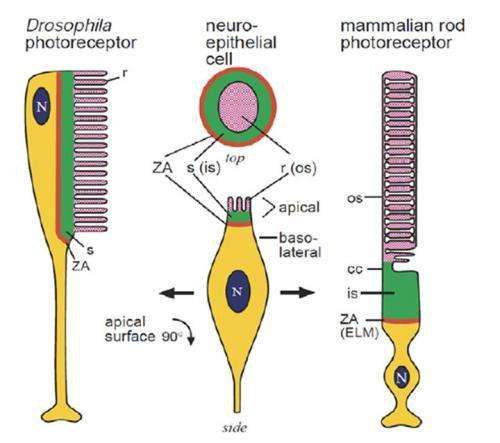June 15, 2018 report
From metabolism to function—the extreme structural adaptations of photoreceptors

One of the most puzzling aspects of cancer is how cells inevitably manage to reactivate precisely those few genes that can turn them into tumors. One example, discussed at length here yesterday, is the restoration of telomerase or alternative telmore repair enzymes that enable indefinite chromsome replication. Another example is the emergency drafting of backup hexokinases to kick off supplementary glycolysis.
Normally, cells maintain a basal level of glycolysis through constitutive expression of the hexokinase I gene. Hexokinases activate glucose by turning it into glucose-6-phosphate. At this point, glucose-6-phosphate can either continue through glycolysis, or shunt through the pentose phosphate pathway to create NADPH, and building blocks for nucleotide synthesis. Many post-mitotic cells that require a more flexible hexokinase use a slightly different version called hexokinase II. Heart and muscle cells need to be able to ramp up their activity to high levels in a short time period. They have a hexokinase II that localizes to the outer membrane of mitochondria where it can readily snap up ATP for to generate glucose-6-phosphate.
The concentration of hexokinase II in cancer cells is typically increased up to 200-fold. These cells can therefore maintain a high glycolytic rate even in the presence of abundant oxygen. This extreme 'aerobic glycolysis' in tumors is frequently called the Warburg effect. Curiously, photoreceptors also show this high hexokinase II expression and aerobic glycolysis, but cancers of the retina are very rare. When tumors do form they usually occur in either the pigment epithelial cells, or early in development in cones that have a double knockout to both copies of their retinoblastoma gene.
The retinoblastoma gene (RB) is known as a tumor suppressor gene. It is critical in controlling the precise number of cells within several sensory systems that build elaborate ciliary structures as detectors. In the cochlea, for example, there is an overpopulation of hair cells and loss of hearing when RB is absent. In adults with hearing loss, it might be possible to regenerate new hair cells by artificially reducing RB activity. Some researchers have even suggested that RB control pathway is the big one that first made multicellular life possible.
The retina is precariously poised at the edge of what is even metabolically possible. It only is able to maintain its prodigious output because of the many special accomodations provided by its unique supporting cells. For example, the pigmented epithelial layer which digests and renews the outer segments of its photoreceptors, or the glial cells in the optic nerve head to which ganglion cells axons outsource mitophagy of their own oxidatively damaged mitochondrial DNA. Both rods and cones must regenerate their lipid rich outer segments at a rate of 10 percent per daily in order to continue to function properly.
The way they both create the building blocks to supply this rapid turnover of biomass is through aerobic glycolysis. But rods and cones do not have the same metabolisms, and correspondingly, they are able to fulfill very different functions. For example, rods are metabolically less costly than cones and consume only about 10^8 ATP per second in darkness. Rod activity also saturates in bright light, while cones, which do not saturate, end up using much more ATP in their downtream signalling pathways.
One way to look under the hood and see what makes rods and cones tick to see what happens when they are put under stress. In a paper recently published in Cell Reports, researchers examined mouse retinas that had hexokinase II deleted from either rods or cones. They also knocked out additional genes to create models of retinal degeneration as occurs in retinitis pigmentosa (RP). To quantify flux through aerobic glycolysis they measured lactate production by varius lactate dehydrogenases (LDH). Approximately 90 percent of the total photoreceptor glucose supply proceeds through aerobic glycolysis to form lactate. LDH mediates the bidirectional conversion between pyruvate and lactate and serves as a switch between aerobic glycolysis oxidative phosphorylation in mitochondria.
The researchers found that rods adapt to decreased aerobic glycolysis by increasing their mitochondrial number while cones do not. Although rods survived, their reduced aerobic glycolysis created a nutrient shortage and subsequent loss of cones. This pattern mirrors the observed primary insult to rods in retinitis pigmentosa which is later followed by cone death. Ultimately, the researchers were able to show that cones are dependant on lactate supplied by rods.
It is speculated that aerobic glycolysis is adapted in rods and cones to provide sufficient glucose inputs to feed their respective pentose phosphate pathways. The subsequent generation of NAPH and lipid synthesis allows each to recycle the appropriate amounts of visual chromophore. Understanding their unique survival requirements is essential to creating therapies to restore degenerating rods and cones.
More information: Lolita Petit et al. Aerobic Glycolysis Is Essential for Normal Rod Function and Controls Secondary Cone Death in Retinitis Pigmentosa, Cell Reports (2018). DOI: 10.1016/j.celrep.2018.04.111
Journal information: Cell Reports
© 2018 Phys.org

















